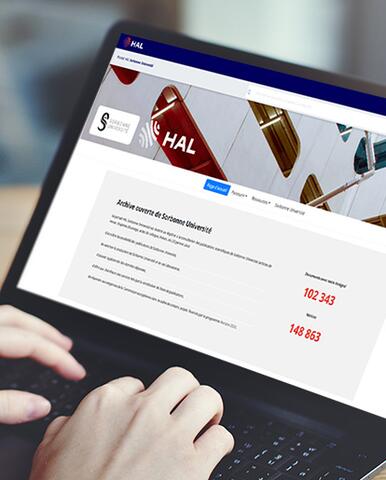

Sorbonne University at the Forefront of Open Science
In February 2023, the HAL Sorbonne University portal reached the milestone of 100,000 articles available in open access.
Sorbonne University is the top French university for open access publications
Anne-Catherine Fritzinger, open science advisor and director of the Sorbonne University Library (BSU), discusses the challenges of this axis of the University’s strategic plan.
What is open access and what do these 100,000 articles deposited in HAL represent?
Open access allows unrestricted and free-of-charge consultation of publications resulting from research. Since its creation, Sorbonne University has encouraged its research community to deposit its publications in the open archive called HAL Sorbonne University. The commitment to open access was formalized in 2019 by the Sorbonne University Charter for open access to publications, but the dynamic was already well underway.
At the beginning of 2023, we passed the milestone of 100,000 articles submitted in full text in the HAL Sorbonne University portal: it is a great success, which is the culmination strong political backing, unfailing support from governance for open science and adherence of the university community to the principle of openness and sharing. This dynamic also owes a lot to the national policy of open science, to the convergence between the policy of Sorbonne University and of research organizations as well as the requirements of research funders in terms of open publications.
The Leiden ranking, which for several years has included an indicator relating to open access to publications, places Sorbonne University at the top of French universities for the rate of free publication access. Sorbonne University is also the first university in continental Europe for the number of publications available in Open Access (5th in Europe, after UCL, Oxford, Cambridge and Imperial College).
How is open access a crucial issue for research, education and innovation in France?
While the entire research process is carried out and financed by public actors, the scientific results are published by commercial publishers. The researchers then pay very dearly for access to their resources (whether through journal subscriptions or of publications conditioning the opening of the article). Today, the cost of the Elsevier license represents nearly one million euros for Sorbonne University and the Open Access publication costs in Nature amount to nearly €10,000 per article! It is an aberrant system in which research teams and establishments are dispossessed of the rights to their work and the results produced. We have come to the end of a crazy system. It is time to react, to stop this infernal machine and restore some common sense to this ecosystem.
For scientists and institutions, the challenge of open access is therefore also a challenge of reclaiming the research process and the results they themselves have produced. It also makes it possible to guarantee the free circulation of scientific publications not only within our research institutions, but also in society, less wealthy countries, for example.
Finally, opening access to publications increases the visibility of articles (an open access article will be cited more than an article accessible only by subscription). It is not insignificant to note that the three French universities at the top of the Leiden ranking for open access to publications are also those that are best ranked in terms of scientific impact. To open up is to increase its impact. In the field of public research, it is also a way of giving back to society what it has helped to fund.
Open science is one of the four axes of the University’s strategic plan. How does it translate concretely?
As of 2019, Sorbonne University adopted a charter to provide free access to scientific publications. In this charter, the university undertakes, as an institution, to raise awareness and support the university community on these subjects and to promote bibliodiversity. In concrete terms, this support is deployed within the Publications & Open Access department of the BSU. It translates into supporting research teams in submitting publications to the HAL Sorbonne University portal and raising community awareness of the challenges of open science. The university pays particular attention to the training of doctoral students; we also rely on the MOOC Open Science that we have created within the Sorbonne University Alliance (ASU) with the National Museum of Natural History.
Open science at Sorbonne University is also a policy of openness and data sharing (in French), developed in conjunction with ASU partners. We are committed to supporting research teams in drafting data management plans, but also in training and raising awareness of good data management and archiving practices. It is not a question of systematically opening the data, but of assessing on a case-by-case basis which must be protected (health data for example) and which must be opened.
By managing your data in compliance with the FAIR principles (Easy to find, Accessible, Interoperable and Reusable) and by adopting good management practices, you create the conditions for the long-term storage of data and make their subsequent opening possible, when their nature allows it. On these subjects too, we pay particular attention to the training of doctoral students and we work with the scientific integrity reference person and the president of the Research Ethics Committee. Because training the community in the proper management of research data means training for in good research practices and research with integrity.
Preserving research data and opening them (or making their opening possible) also means, in the disciplines where this is relevant, making the research reproducible: knowing that the majority of situations of scientific misconduct concern either publication signatures, or data manipulation, it is easy to understand the challenges of raising community awareness on these subjects.
What is the purpose of the Open Science Barometer (BSO) implemented by the Ministry of Higher Education, Research and Innovation?
This barometer, deployed on a national scale https://barometredelascienceouverte.esr.gouv.fr/ following the launch of the first national open science plan adopted in 2018, measures the evolution of the share of open access publications, according to disciplines, publishers and type of open access (open archive or green Open Access, open access for publishers or gold Open Access). Based on the script produced by the University of Lorraine, we were able to deploy the BSO across Sorbonne University. The results are up to the ambition of Sorbonne University in this area and confirm the analysis of CWTS Leiden Ranking (ranking 2022) which attributes a rate of 79% of publications in open access to Sorbonne University for the period 2017- 2020, thus positioning it as the French university with the highest open access rate.
According to the Sorbonne University BSO, 78% of Sorbonne University publications published in 2020 are open access. This rate is 62% nationally. In some disciplines, such as physical sciences, astronomy, mathematics and earth sciences, we have an average rate of publication openness of between 85 and 90% (see national results). In the field of medical research, the open rate of publications is 10 points higher than the national rate.
This excellent record, which is the result of Sorbonne University's lasting commitment to open science, should not, however, make us forget that one publication in five within our university remains inaccessible (except through very expensive subscriptions).
The question of the research evaluation system remains the keystone of open science, does it not?
Absolutely. If we want to change research practices and the principles of openness and sharing, it is necessary to change the research evaluation system. We must gradually stop valuing the impact factor of the journal or the quantity of articles published in favor of the intrinsic quality of the scientific work. This is why, as an extension of its policy of openness, the governance of the university has naturally brought this change: first by adopting from 2021 a policy of promoting actions for open science in internal evaluation, then by signing the San Francisco declaration on the evaluation of research (DORA) https://sfdora.org/read/ , finally by very recently joining the European coalition COARA and by signing, in November 2022, the agreement on the reform of research evaluation.
The High Council for the Evaluation of Research and Higher Education (HCERES) is now part of the same dynamic since it includes in its evaluation grid indicators relating, among other things, to the openness of publications.
